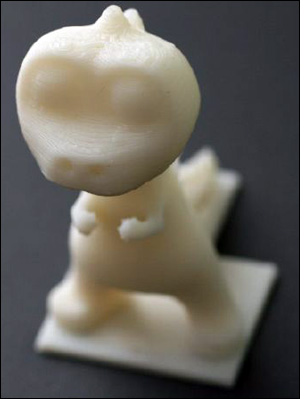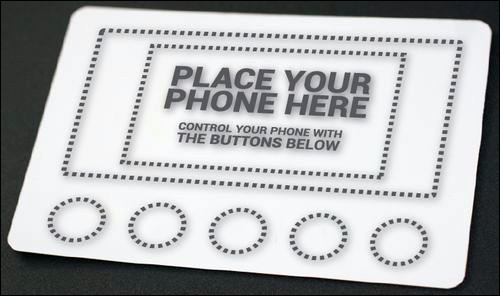Near Field Communication (NFC) RFID technology startup Flomio is bringing gaming to sales events, concerts and festivals, with a service that embeds NFC RFID tags in three-dimensional plastic objects. Flomio got its start in 2012 with the launch of its FloJack NFC reader module for the Apple iPad, the iPhone and newest version of the iPod Touch. The firm was successful in its effort to raise the funds it needed to bring the FloJack to market (see NFC App Developer Flomio Looks to Kickstart Its NFC Reader for Apple Devices), says Richard Grundy, the company’s founder, and the first units are expected to be shipped next month.
Now, Flomio is bridging the gap between the gaming industry and the real world, with NFC RFID tags built into toys, figurines and other small plastic items, known as 3D Printables, that can be interrogated by readers on game consoles or mobile phones, or at concerts or other public events.
Customers can send Flomio a 3D solid model file (in .stl format), and choose the object’s size, up to 15 cubic centimeters (0.9 cubic inches), tag type and color of plastic (white, green or blue). Flomio will then employ a 3D printer to manufacture that object, with the RFID tag embedded inside. The company charges 50 cents per cubic centimeter, as well as a $4 handling fee per item, plus the cost of the NFC tag and shipping.
“Once customers are satisfied with the product and its read performance,” Grundy explains, “Flomio offers large-scale manufacturing services as well. Costs vary based on material, quantity and turnaround time.”
Plow Digital, which creates games for cell phones, tablets and other mobile electronic devices, as well as for Web sites, is currently in discussions with customers looking to use the 3D Printables with the Plow Digital interactive software as part of their own marketing events, or at other festivals or shows.
For example, says Greg Phillips, a partner at Plow Digital, Audi is presently in talks with his firm regarding the use of Flomio’s NFC technology and Plow Digital games as part of a new vehicle launch, with a small figurine containing a built-in NFC RFID tag. Guests at the launch could receive the figurine upon checking in, at which time they would provide a name and other information, and then proceed to participate in games or contests at stations throughout the facility, thereby creating a scorecard with accumulated points that could earn that person a reward. Teams could be synched together, with their total earnings added up in Plow Digital’s software.
In another use-case, a beer brand may offer the technology for attendees at music festivals, allowing them to play games in order to earn a free beer—once they provide identification proving they are 21 years of age or older.

According to Phillip, Plow Digital already sells NFC solutions with such items as cards or wristbands, in addition to readers supplied by several NFC technology providers, to enable users with NFC-enabled cards or other objects to access digital content or games in places where readers are installed. However, he says, the company’s clients often prefer to keep details regarding their solutions to themselves, believing their ideas to be so innovative that describing them could eliminate their competitive edge.
The 3D Printable system follows Activision Blizzard‘s Skylanders concept, in which players acquire NFC RFID-enabled figurines representing characters in the video game (see NFC Technology Brings New Life to Games). Game consoles require an RFID reader that can be plugged into the game console, and players’ characters are interrogated by the reader in order to determine who is playing, as well as his or her score. “We take that same concept and make it mobile,” Grundy says, by enabling users to play games away from their console, either at an NFC-enabled kiosk or on a mobile phone or tablet.
Plow Digital and other gaming companies are offering marketing solutions based on Flomio’s 3D Printable technology. For example, upon arriving at a concert, festival or marketing event, an individual acquires a 3D item, such as a squishy ball or a plastic bottle cap, branded by an advertising company. The user can then take that object (which has an embedded NFC RFID tag) around the site and play games with NFC readers, earning points and then perhaps redeeming them for rewards, such as a free drink. Those with NFC-enabled phones could use their handsets (instead of the 3D item) to play the same games, or utilize the handset or a tablet as a reader, along with the 3D item, to continue playing on a phone after the event concludes.
Plow Digital utilizes Flomio’s cloud-based server and software, which, in turn, implements Plow Digital’s interactive gaming technology. Data related to every transaction—and, therefore, the points earned for each item—would be collected and calculated on Flomio’s cloud-based server. Other data could also be connected that would provide such analytics as when, and in what order, individuals reached specific game sites.
To date, Flomio reports that it has sold its 3D Printable items in small quantities directly to buyers, for them to sample with a variety of solutions. “No large deployments have come about yet,” Grundy notes, “although we have had several mobile gaming companies interested [in addition to Plow Digital], and are excited to work with them to bring more ideas to life.”
In addition, Flomio is selling a beta version of the Gema Tag—produced by Gema Touch—containing five RFID inlays manufactured with NXP Semiconductors‘ Mifare Ultralight chip. Each RFID inlay can be rendered operable at the press of a button. A user could place his or her NFC-enabled phone on the tag and receive different content, depending on which button was pressed on the tag, and thus which inlay it read. The Gema Tag could be embedded in a poster, a flyer or a magazine page.
Flomio is also working with Kyp to build tailored solutions as part of Kyp’s printed marketing product offering that utilizes Flomio’s NFC Actions technology. NFC Actions is an Android app that would enable Kyp’s customers to write instructions to NFC tags in order to open a URL, check Foursquare or perform other actions. In this way, recipients of a mailer or flyer could use an NFC phone to access considerably more targeted information than is printed on the page. NFC tags built into such mailers or pages, Grundy explains, could provide an alternative to the USB stick many marketers distribute to share large amounts of data regarding a product or service in a small space.
A new company known as Capify intends to sell baseball caps with built-in NFC tags that also utilize Flomio’s NFC Actions app to direct a user’s NFC phone to a Web site, a video about a team whose logo is printed on the front of the cap, an individual’s URL or other data. Those caps are expected to be available later this year, the company reports, though small quantities are currently available for purchase at Flomio’s Web site.
For all of its use cases, Flomio is employing NFC RFID chips supplied by Verayo, Kovio or Texas Instruments.
The FloJack, manufacturing of which is slated to commence at the end of this month, will include another Flomio innovation: a tag sniffer. The reader remains dormant while the sniffer sends very small pulses of energy through FloJack’s antenna. The sniffer measures how that power decays (a slow decay rate would indicate no tag being present, while a fast rate would signify a tag’s presence), in order to determine if a tag is in the vicinity. If one is, then the sniffer activates the reader to begin transmitting a signal to interrogate the tag. This saves the life of the FloJack’s internal 3-volt lithium battery, the company reports.



